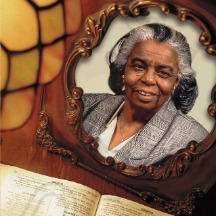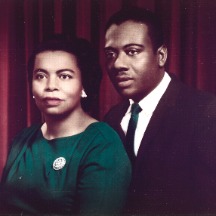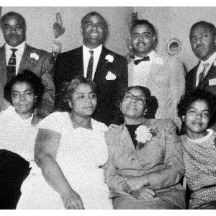Maggie Louise Hearon Young’s roots in Forrest City, St. Francis County, Arkansas date to at least 1900 when her paternal grandfather, Armstead Hearon, left Caledonia, Lowndes County, Mississippi for Forrest City sometime after his first wife, Sally, died. Louise’s maternal grandparents, Henry and Sally Cook Barnes, casted their bucket in St. Francis County by the taking of the 1910 Census.
During The Great Black Migration, from about 1916 to about 1970, more than six million African Americans from the rural South relocated to cities in the Northeast, Midwest, and West. Louise, her husband Johnie, and their daughters, Grace and Willa, were four of the six million.
Johnie and Louise married Saturday, December 10, 1949. At 91-years-old, Louise recalled, “1949 was the last year we picked cotton. I think.” They married at 401 Franklin Street in Forrest City. Reverend James Barnes, one of her mother’s brothers, married them.
She added, “In those days most people who lived out in the country stayed with some family member to go to (high) school.” Her experience with access to education is echoed in “The Education of Blacks in the South 1860-1935” by James D. Anderson.
St. Francis County has been Johnie’s family’s home since at least 1878, during the Reconstruction era. He had farmed his great grandparent’s original acreage with his maternal grandmother until his new family moved to Gary, Indiana in 1951.
Johnie left Arkansas first. He left the South shortly after Willa was born. In the Steel City, he lived at 1538 Connecticut Avenue with his first cousin Lloyd Stanley and Lloyd’s wife, Willa, who was also Johnie’s sister-in-law.
Louise left The Razorback State with “an eight-year-old daughter and a baby in my arms,” in about 1951 or 1952, she continued. The threesome took the Chicago, Rock Island & Pacific, more commonly known as the Rock Island, train from Forrest City to Memphis. Like others before them, they took the Illinois Central from Memphis to Chicago. From Chicago, Louise recalls getting to Gary on the Chicago South Shore and South Bend Railroad.
When Louise and children arrived in Gary, all four members of the family moved into a room rented from Maggie Pennington. However, they had access to the whole house at 1568 Polk Street. Then, they moved to Lloyd and Willa’s for about a year at 1538 Connecticut, until they moved to 1823 E 19th Court in the Dorie Miller Housing Projects.
Permanent, federally funded housing was part of President Franklin Roosevelt's New Deal in 1936. When the Young’s moved into Dorie Miller around 1953, they were some of its first tenants.
They stayed there for two or three years before moving in 1955 to 1924 Hovey Place, the same year that another child, Lorraine, was born and died. She is buried in Fern Oaks Cemetery in Griffith, Indiana. “I was still in the hospital. I could not even make it to the funeral,” says Louise, who almost died from childbirth. She survived after the doctors massaged her heart.
They then had Wayne in 1960 and Derrick in 1963. Over the years, Louise was an active housewife. During the times the boys attended school at Ivanhoe Elementary, she headed the school’s Parent-Teacher Association.
Back in Arkansas, she and Johnie attended Fedison Grade School in the Telico community until grade eight. Doc Gatewood, who was her future mother-in-law’s first cousin, was one of her teachers. A large amount of the human body is water and is necessary for our survival, “otherwise our bodies would burn up,” is a lesson from Gatewood she still repeated at age 91.
From Cotton to Steel: A Life Well Lived



When Louise attended Lincoln (Colored) High in 1949, she left her parent’s rural home and stayed with Estelle and Otto Peoples on Water Street. Louise’s aunt Nancy Cook Peoples (Larimore) married Robert Peoples, who was related to Otto. She added, “In those days most people who lived out in the country stayed with some family member to go to (high) school.” Her experience with access to education is echoed in “The Education of Blacks in the South 1860-1935” by James D. Anderson.
“I was not there long,” she added thinking of that eventful year, 1949, that she also got married and maybe stopped picking cotton.
“I was not there long,” she added thinking of that eventful year, 1949, that she also got married and maybe stopped picking cotton. After giving birth to five children, Louise continued her education and earned a GED from Lake Ridge Adult Education in May 1979.
She latter briefly attended Ivy Tech State College and Purdue Adult continuing education for seniors. After having training in floral arrangement at Manpower and Ivy Tech State College, Louise operated the home-based Louise’s Flower Shop from 1973 to 1990.
In 1973, Johnie passed and is buried in Evergreen Cemetery in Hobart, Indiana. He had been a deacon at First Baptist Church of Gary. Louise, who had been baptized at an early age at Telico Baptist Church in Forrest City, became a deaconess at First Baptist in 1974.
While many Blacks began migrating from the Republican to the Democratic Party during President Franklin Roosevelt’s term (1933-1945), this was one migration that Louise would not make. She served as a Republican precinct committeeperson for about ten years. For some years, she served as Vice committeeperson with an immediate neighbor serving as chairperson. She also served as the President of the Hovey Place Block club that was associated with the Urban League’s block club program. As a senior, she was active with the Northwest Indiana Community Action.
Over the years Louise worked at Indiana Hooper Hotel as a maid, Indiana Legal Service, and for 21 years mainly as a teacher’s assistant with the Gary Community School Corporation (Vohr Elementary, 4 years; Beveridge Elementary, 4 years; Washington, 2 years; Alain Locke, 11 years; and Beveridge, 1 month) before retiring in 1996.
Louise is preceded in death by her husband Johnie; one child, Lorraine; and all of her brothers and sisters. Her legacy on earth continues with her children Grace Vincent (Joseph Vincent, Sr, deceased), Willa Banks (Joseph), Wayne, and Derrick (Gale). Grandchildren, Joseph Vincent, Jr; Afra Vincent; and Jonathan (DeMeita); Joshua Banks; Elizabeth Banks (Emeka Anyanwu); Daris Young (Leena); and Amari Berry (Keon). In addition, great-grand-children Demetrius, Joron, Arielle, Autumn, baby Anyanwu (on its way), Aurora Young, Zaria Berry, and Ava Berry. In addition, bonus granddaughter Rhonda, a host of nieces, nephews, cousins, neighbors here and who have moved afar, and special friends.
Note: As appeared in her obituary for services held Saturday, April 30, 2022; First Baptist Church of Gary; Gary, IN. Eulogy delivered by her youngest son Pastor Derrick E. Young; M.Div.; APBCC Senior Pastor; Unity Baptist Church; Jacksonville, FL.
Also Read: How One Family Faced a Medical Crisis Across the Miles - Adjustments were made, but our first immediate family crisis (in circa 1998) tested our ability to handle problems across the miles. Well, it may have added 24 additional years to mom's life – 24 years to happily sit on her porch.
“I was not there long,” she added thinking of that eventful year, 1949, that she also got married and maybe stopped picking cotton.
“I was not there long,” she added thinking of that eventful year, 1949, that she also got married and maybe stopped picking cotton. After giving birth to five children, Louise continued her education and earned a GED from Lake Ridge Adult Education in May 1979.
She latter briefly attended Ivy Tech State College and Purdue Adult continuing education for seniors. After having training in floral arrangement at Manpower and Ivy Tech State College, Louise operated the home-based Louise’s Flower Shop from 1973 to 1990.
In 1973, Johnie passed and is buried in Evergreen Cemetery in Hobart, Indiana. He had been a deacon at First Baptist Church of Gary. Louise, who had been baptized at an early age at Telico Baptist Church in Forrest City, became a deaconess at First Baptist in 1974.
While many Blacks began migrating from the Republican to the Democratic Party during President Franklin Roosevelt’s term (1933-1945), this was one migration that Louise would not make. She served as a Republican precinct committeeperson for about ten years. For some years, she served as Vice committeeperson with an immediate neighbor serving as chairperson. She also served as the President of the Hovey Place Block club that was associated with the Urban League’s block club program. As a senior, she was active with the Northwest Indiana Community Action.
Over the years Louise worked at Indiana Hooper Hotel as a maid, Indiana Legal Service, and for 21 years mainly as a teacher’s assistant with the Gary Community School Corporation (Vohr Elementary, 4 years; Beveridge Elementary, 4 years; Washington, 2 years; Alain Locke, 11 years; and Beveridge, 1 month) before retiring in 1996.
Louise is preceded in death by her husband Johnie; one child, Lorraine; and all of her brothers and sisters. Her legacy on earth continues with her children Grace Vincent (Joseph Vincent, Sr, deceased), Willa Banks (Joseph), Wayne, and Derrick (Gale). Grandchildren, Joseph Vincent, Jr; Afra Vincent; and Jonathan (DeMeita); Joshua Banks; Elizabeth Banks (Emeka Anyanwu); Daris Young (Leena); and Amari Berry (Keon). In addition, great-grand-children Demetrius, Joron, Arielle, Autumn, baby Anyanwu (on its way), Aurora Young, Zaria Berry, and Ava Berry. In addition, bonus granddaughter Rhonda, a host of nieces, nephews, cousins, neighbors here and who have moved afar, and special friends.
Note: As appeared in her obituary for services held Saturday, April 30, 2022; First Baptist Church of Gary; Gary, IN. Eulogy delivered by her youngest son Pastor Derrick E. Young; M.Div.; APBCC Senior Pastor; Unity Baptist Church; Jacksonville, FL.
Also Read: How One Family Faced a Medical Crisis Across the Miles - Adjustments were made, but our first immediate family crisis (in circa 1998) tested our ability to handle problems across the miles. Well, it may have added 24 additional years to mom's life – 24 years to happily sit on her porch.
Advertisers | Contact Us | Events | Links | Media Kit | Our Company | Payments Pier
Press Room | Print Cover Stories Archives | Electronic Issues and Talk Radio Archives | Writer's Guidelines






